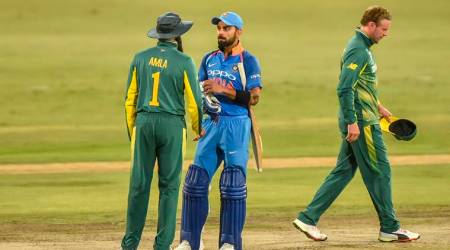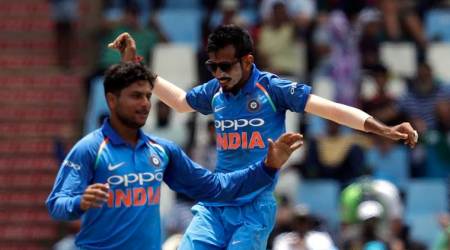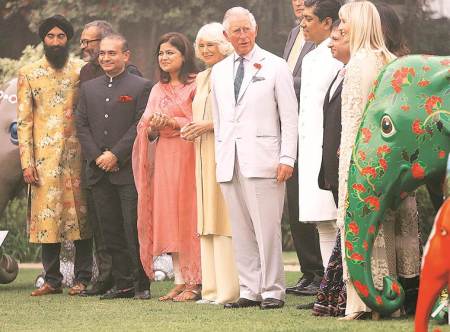 Over the years, Indian captains have had to deal with a senior player overstaying their welcome. Refreshingly, this hasn’t been the case between Virat Kohli and MS Dhoni. Not yet at least. (Illustration by Subrata Dhar)
Over the years, Indian captains have had to deal with a senior player overstaying their welcome. Refreshingly, this hasn’t been the case between Virat Kohli and MS Dhoni. Not yet at least. (Illustration by Subrata Dhar)
“They don’t fit in my team.”
Sushant Singh Rajput, playing Mahendra Singh Dhoni in the eponymous 2016 biopic, ‘M.S. Dhoni: The Untold Story’, on three seniors.
Throughout his fabled captaincy career, Dhoni has appraised many a cricketer of varying reputation. Sometimes openly in press conferences, at other times privately during selection meetings, but always brutally impersonally. His sharp, uncluttered mind cut the noise and saw things as they were. If he deemed Sachin Tendulkar, Virender Sehwag and Gautam Gambhir-nine months after they had won him the 2011 World Cup-were conceding 20-30 runs in the field, he would say so, coldly cutting close to the bone. He would figure out pretty soon that Ajinkya Rahane, for all his promise and overseas batting record, wasn’t cut out for a middle-order role in limited-overs cricket.
Time is a great leveller, however, and the old Dhoni is not the Dhoni of old. There’s a tangible decline in his contributions with bat, and the question he once asked of others is begging to be asked of him now. But the one whose decision matters, Virat Kohli, remains convinced he needs Dhoni for the 2019 World Cup in England. The incumbent India skipper Kohli, as tough and demanding as he is, often betrays the impression of being emotionally invested in his picks. His predecessor, notwithstanding murmurs of a bias towards a few Chennai Super Kings players, was detached. It makes you wonder how Dhoni would’ve audited his recent performances. To go back to the movie, would Dhoni 2018 fit in Dhoni 2011’s team?
 Virat Kohli remains convinced he needs Dhoni for the 2019 World Cup in England. (Source: AP)
Virat Kohli remains convinced he needs Dhoni for the 2019 World Cup in England. (Source: AP)
It won’t be an easy decision as various thoughts might jostle for prime space. Undoubtedly, Dhoni the batsman isn’t the same; he doesn’t finish games as before, he coughs up a lot more dot balls, even his apparently well-connected hits don’t always clear the boundary, the extra fielder in the deep warranted by new rules has hampered him – above all his greatest signature style of taking the match down to the last over now looks not as an act of choice but of helplessness to finish.
That’s the beauty of Dhoni’s career – there is always a “but”, especially when the dice seemingly is loaded against him. One more time there are debates about his place in the side, “but” he is still the best man for the job.
The best stumper in the world, the lack of a genuine alternative, the invaluable wisdom from behind the stumps to two relatively young spinners, and the priceless presence of being Dhoni. The value of Dhoni is seen best in the opponent’s reaction; the outside world rates him higher than home-grown disillusioned. In 2015, at the end of India’s World Cup campaign, when MS Dhoni was leaving the press conference room, he ran into the victorious captain Michael Clarke. The Australian stopped him, and asked, “Hey mate, what is it I am hearing, you might retire.” As Dhoni smiled, Clarke went on, “No, no mate, you are good enough to play till the next World Cup.” It looks like the Indian camp has also started to listen. And now the cold rationalist fans would also have to agree with Clarke’s assessment.
 The best stumper in the world, the lack of a genuine alternative, the invaluable wisdom from behind the stumps to two relatively young spinners, and the priceless presence of being Dhoni. (Source: AP)
The best stumper in the world, the lack of a genuine alternative, the invaluable wisdom from behind the stumps to two relatively young spinners, and the priceless presence of being Dhoni. (Source: AP)
“What I’m most happy about is that he’ll be able to play free cricket and express himself as the aggressive MS Dhoni we knew when he first came into the team. As a player, responsibility (captaincy) can take that away from you.”
Virat Kohli, after taking limited-overs reins from Dhoni in January 2017
Cricket is an individual pursuit in the garb of a team sport. Each performance on a cricket field can be broken down into solid, easily comprehensible numbers. It can be postulated, therefore, that in order to survive, you only need to hit more runs/take more wickets than your teammates and not necessarily the opposition. In short, you don’t need to outrun the bear, only the man next to you. Leadership in cricket demands selflessness, and therefore can be counter-intuitive. No wonder that captaincy wears most, even the best, down.
But it does liberate some. With Dhoni, captaincy complemented his cricket. As is the case with Kohli now, he revelled in responsibility. His batting average, in ODIs (53.9 against 46.9) as well as all the three formats (47.05 vs 41.38) put together, shoots up by six runs per innings as captain. The top job made him go prematurely grey, but it also made him great.
Post the 2015 World Cup in Australia and New Zealand, his batting stock plummeted. In this period, as captain, his batting average dropped to 35.9. Now it can be the natural decline of an ageing batsman, or the fact that captaincy caught up with him, or both. Conversely, it can also be deduced that giving up the Test responsibility in December 2014 didn’t as much unburden him as it undid him.
Then, in January 2017, he said “Ok, that’s it” to India’s limited-overs captaincy as well and put himself in the pool to be picked purely on the basis of his performance. A cursory look at his numbers since January 2017 strongly suggests that the move has worked. Since then, he averages a whopping 57.13 as against 50.89 previously, though his strike-rate does come down by nearly four percentage point. Fair trade — seven extra runs per innings for four fewer per hundred balls? Not quite, if you scratch the surface.
 There are multiple aspects that is causing the decline in Dhoni’s batting. (Source: REUTERS)
There are multiple aspects that is causing the decline in Dhoni’s batting. (Source: REUTERS)
Here’s the thing with calculating batting average: As it subtracts the number of times a batsman has remained unbeaten from total innings played, it tends to give an inflated figure, especially in the case of lower-middle order batsmen who end up unbeaten more often than top order ones. The traditional arithmetic mean — total runs divided by total innings — will paint a more accurate picture. And it’s not pretty: Dhoni is scoring 4.1 fewer runs per innings (32.9) than he was before January 2017 (37). Over the last two years, the deficit becomes six runs per hit. Batting second, which was once considered Dhoni’s turf, the fall is precipitous: 9 runs per innings (from 34 to 25).
Now, it was alright if his runs were coming at a better clip — something Kohli expects of him in the aforementioned statement — but that, as we have seen, is not the case. And there are no Yuvraj Singh and Suresh Raina to share his burden in the middle order. With their contributions, they also made Dhoni the finisher he once was. [And they too benefitted from Dhoni’s presence as it afforded them the licence to hit.]
There’s not one aspect of Dhoni’s batting that is causing this decline. On the general evidence of the last one year, and particularly the first four matches of the South Africa series, he is playing far too many dots balls (46 percent), even though he remains, even at nearly 37, among the best runners between the wickets going around. Even in his pomp, Dhoni used to take time to settle down. He spoke about it in 2016, after a rare half-century in a particularly bad year. It came after he had promoted himself up the order. “I was not getting the kind of batting that is important for me to be fluent in the rotation of strike…The deliveries really matter. You want to play a lot of deliveries,” he had said.
However, what accentuates the problem is that, unlike five years ago, he can’t seem to summon the release shot easily and frequently. His boundary per innings ratio has fallen from nearly 3 to 2.3, thanks in part to the extra man along the rope. And while he is hitting as many sixes as before, the perception is that he is struggling to clear the fence with ease.
There was an acknowledgement of sorts last year when he tried to remodel his stance and his bat-swing. For someone with a homemade but very effective technique, having to rush to a performance-analyst was the surest sign the crisis was getting to him. It is akin to Arnold Palmer seeking out a swing guru to deconstruct his swing, which was self-made and unaesthetic, but had yielded the King 7 Majors.
The great Ben Hogan once said ball-striking and putting were two different sports. What may be inferred from this is that you can good at one and middling at the other and still be a competitive golfer. The same could be said of the three cricket formats. And Dhoni’s diminishing returns with bat have coincided with him upping his game considerably behind the wicket.
“Dhoni has got his own style, which is so successful for him. I think we can do research on his style of wicketkeeping and I would like to call it the ‘Mahi-way’. There are so many things to learn from that and there are so many things which the young keepers may not even be able to contemplate. He is unique in his own way.”
R Sridhar, India’s fielding coach.
For a comfortable majority of his career, of all things Dhoni, wicket-keeping was his most anonymous skill. First he captured our imagination with his hairstyle, then with destructive batting, then came captaincy and ice-cool finishes. It’s only now, in the twilight of his career, that his wicket-keeping is getting its due recognition.
His evolution has been remarkable. In fact, when he made his debut, India wasn’t so much looking for a keeper as a decent bat who could take the gloves from Rahul Dravid and ease his burden. One of the first memories of his wicket-keeping that come to mind are of his misses. And none more enduring than the Shahid Afridi reprieve off Ashish Nehra in Ahmedabad in 2005 that nearly had the bowler unhinged. Dhoni’s glove-work back then was pejoratively likened to his previous pursuit: goalkeeping.
A quick learner, he grew on the job. And it’s not just because he is no more the captain, or because his batting is on the wane, it is his keeping that has become more discernible. The senses have heightened, the hand-speed has become lightning. Against spin, Dhoni gives the impression that, like a fly, he sees things in super slow motion.
It’s here that Dhoni scores over competition. With India looking all set to take two wrist-spinners — Kuldeep Yadav and Yuzvendra Chahal — to England for the World Cup, he has become virtually indispensable.
[Perversely, it’s because of Chahal and Yadav that there is more pressure on his batting. With Ravichandran Ashwin and Ravindra Jadeja, India batted deep, but with Chahal and Yadav the tail has grown longer.]
 It’s only now, in the twilight of his career, that his wicket-keeping is getting its due recognition. (Source: Express Photo by Kamleshwar Singh)
It’s only now, in the twilight of his career, that his wicket-keeping is getting its due recognition. (Source: Express Photo by Kamleshwar Singh)
Some will point out that Wriddhiman Saha has all those qualities and he dives around to edges that fly off, too. And that he is younger and bats none too worse than this avatar of Dhoni. As proof of how well he handles pressure in big tournaments, they may cite his century (a 55-ball 115) in the 2014 IPL final. Which are all fair points, but there are others pressures too that an Indian keeper gets to face. Can he, for example, remain unflappable when in a tense World Cup match, an overeager Kohli goes charging at him, demanding to know if the turned-down lbw appeal be reviewed? In such a situation, most Indian fans would want a certain greying 37-year old to be there and talk sense into Kohli.
“If you’re Virat Kohli, you’ll actually be hoping that MS Dhoni does really well and is able to hold on to his place. Because you would like that kind of experience performing well in the team. Just that knowledge would be priceless for Virat Kohli to have.”
Rahul Dravid, speaking to ESPNcricinfo after Dhoni quit limited-overs captaincy
Historically, Indian captains have had a thorn in the sides in the form a senior player (often a former captain) overstaying his welcome. Mohammad Azharuddin had Kapil Dev to deal with; Sachin Tendulkar had Azharuddin; then MS Dhoni found himself dealing with Tendulkar in a vainglorious pursuit of the 100th hundred. Refreshingly, this hasn’t been the case between Kohli and Dhoni. Not yet at least. And Kohli and team stand to benefit from it.
Already we see Dhoni acting as a spin-bowling captain, coaxing the best out of the young wrist spinners. If India can sort out their No.4 and 5 issues and once Hardik Pandya becomes a bit more consistent, the decline in Dhoni’s batting, too, wouldn’t get unduly magnified. That said, India need to keep a backup ready to deal with any eventuality.
In 2011, the Indian team was lucky it had Dhoni the strategist, Dhoni the batsman and Dhoni the stumper all in the peak of their powers. It was a rare alignment of stars. Looking forward to 2019, Virat Kohli has Dhoni still capable of performing two out those three roles with aplomb. It’s still a luxury no Indian captain ever had, save Dhoni himself.
For all the latest Sports News, download Indian Express App
- Feb 18, 2018 at 8:05 amOne can commit as much jugglery with words but the fact remains that Dhoni is a fossil today , just as Kapil and Tendulkar were late in their s .So the moot point is why are the coach and the captain so fond of Dhoni .Is it because of Dhoni's superior wicket keeping , his experience or because of the belief that Dhoni as a batsman can still come good despite almost conclusive evidence to the contrary ? None of the above . Indians and to some extent all human beings are clannish , so you hear the phrase 'he was /is great ,so we owe it to him to let him retire on his terms . In addition to his cricketing prowess , Dhoni has handled his cricketing better than most .I can't remember too many captains giving up captaincy in their prime .So Kohli is indebted further than just normal clannishness.Reply











